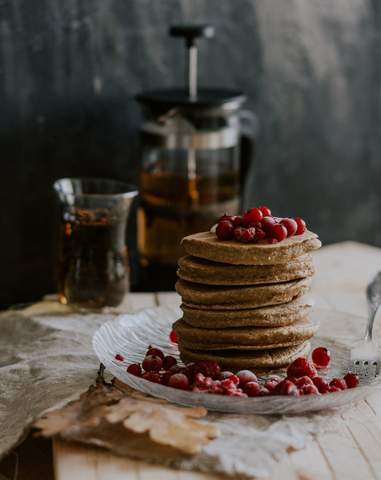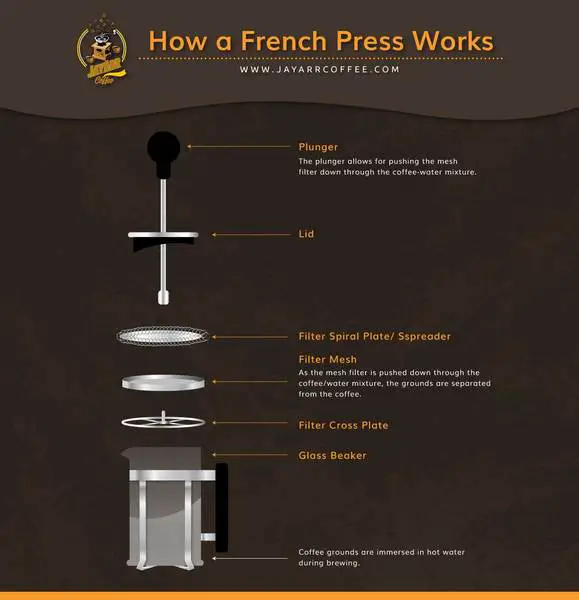For those looking to up their coffee game from a standard drip brewer, the French press is a great, and easy to use, next step. Not only does a French press provide great results, it also brews coffee in less time than a traditional coffee machine.

For your information, if you click on a product on Jayarrcoffee.com and decide to buy it, we may earn a small commission.
What are the Advantages of Using a French Press?
But what makes a French press so much better than a regular coffee machine?
Well, to start, a French press is an immersion brewer– that means that the coffee brewed is completely immersed in water. Immersion brewers are generally very good at producing an evenly extracted brew. The French Press also utilizes an integrated mesh filter, making it perfect for someone looking for a more eco-friendly brewing method by making paper coffee filters a thing of the past. A French Press is also fairly cheap (~ $30) and is actually very easy to use. Coffee produced from a French press also is high in antioxidants that some studies have found can have neurological benefits.
One of the downsides of a French press, which is keeping the brewing water at a hot enough temperature, can easily be circumvented by preheating all glassware and the press beforehand.
How Does a French Press Work?
The three main components will be a brew chamber, a lid with a spout, and a removable steel mesh filter attached to a plunger. This steel filter is what really separates the French press from a drip brewer because, while a paper filter will soak up most of the flavorful coffee oils, a steel filter allows all of it to pass into the cup.

The mesh filter has a 3 piece sub-assembly of a spiral plate/spreader on top, a filter in the middle, and a cross plate on bottom.
Ok, So How Do I Make Coffee with a French Press?
Here are 10 steps for making great coffee with a French Press:
- Freshly grind your coffee beans. It is important to use a coarse grind. Most grinders will have a suggested French press setting, and it usually does a good job. However, if you find that the coffee tastes too bitter, going slightly coarser will help. And if the coffee is too weak, going a notch or two finer should get the job done.
- Prepare hot water slightly cooler than boiling (about ~205 F). This can be accomplished by boiling water and removing it from heat for about 30 seconds.
- Fill your French Press about ¼ of the way full with the hot water. Depress the plunger to the bottom of the French Press.
- Shake the water inside the french press to pre-heat the glass. Pull the plunger to the top of the press, remove the lid, and set it aside. Pour the hot water out of your press.
- Add the coarsely ground coffee to your press. Generally, an appropriate ratio of coffee to water is 2 tablespoons of ground coffee per 1 cup of water. Give the press a shake to settle the grounds.
- Pour half of the water over the grounds into your press. You will see the grounds bubble up (“bloom”) in the bottom of the press. As the coffee blooms, the top of the water will form a “crust”. Start a timer.
- Once the timer hits 30 seconds, stir the mixture gently for 5 seconds to break up the crust on top and in order to mix the contents evenly.
- Pour the rest of your hot water into the mixture. Reattach the lid with the plunger fully pulled up.
- Let the mixture steep for 4 minutes.
- When your timer reads 4 minutes, press down on the plunger slowly and evenly until it reaches the bottom. This will filter the grounds from the coffee. You can now pour your coffee. Pro-tip: Don’t let the coffee stay in the press too long or it will overextract and taste very bitter!
Cleanup is thankfully a breeze with a French press. The first step of this is to dispose of the spent coffee grounds inside, which can either be dumped into the trash can, added to a compost bin, or even scattered over plants. It might not be a good idea to dump them straight down the kitchen sink though unless you have a garbage disposal.
Most French presses are completely dishwasher safe – just make sure to fully disassemble and separate the filter plates to ensure a quality clean.
